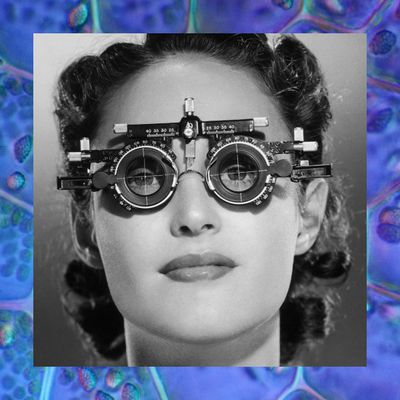
Welcome to Am I Dying, a column that hopes to save you from your late-night WebMD spiraling. You can email us your hypochondriac questions at [email protected].
I wear my contacts as much as the next nearly blind gal (12 to … 16? 18? hours a day) and I assumed that was fine because I go to the eye doctor every year like I’m supposed to and I don’t use water as contact solution anymore (lol, college) and I throw them out about as often as I’m supposed to. (Maybe every six weeks instead of every month.) But then I read some story about someone going blind from wearing their contacts too much and now I am convinced that is my fate also. Help!!!
Okay, this much I can tell you right now: Eighteen hours a day is way too much contacts time. Sixteen hours probably is, too. I know this because I went to the eye doctor recently and got in trouble for wearing my contacts too much, and I wear mine 14 or 15 hours a day. Apparently, I am growing blood vessels on my corneas, which is a symptom of hypoxia, or oxygen deficiency. (Did you know, before right now, that your eyeballs needed to … breathe? I don’t know, it just never occurred to me!) My doctor told me my case was mild, but in order to keep it from getting worse, he told me to limit my contacts hours to 1o or 12 a day. I haven’t been doing a very good job cutting down, and truthfully, I should probably be wearing them even less.
Dr. Ilyse Haberman, an ophthalmologist at NYU Langone Health, tells me the general recommendation she gives patients is to limit their contact lens use to 8–10 hours a day, or the average workday. But there’s no fixed number of hours that are “safe,” just as there isn’t any threshold beyond which you’re destined to have a problem. “It’s different for every person, because some people never have problems, and some people have problems from wearing them for five hours,” she says. Your best bet is limiting your contact lens use as much as possible, because incorrect and/or excessive contact lens use can lead to infection, which, in rare cases, can lead to blindness.
For optimal, safe contact lens use, Dr. Haberman advises patients avoid “the three S’s”: swimming, sleeping, and showering in contacts are all no-nos. Two of the three have to do with water, which presents one of the greatest risks for eye infection to contact wearers, says Haberman. Most of these infections, called corneal ulcers, can be treated successfully, says Haberman, but when they’re larger, or left untreated, they can eat through the tissue of the cornea, leading to sight loss.
There is also the risk, however rare, of Acanthamoeba Keratitis (or AK), a type of eye infection caused by a microorganism found in some tap water and swimming pools. (Haberman says AK is uncommon in New York; there is some research that suggests AK outbreaks may crop up after regional flooding.) In some cases, even washing one’s hands with tap water and failing to dry them properly can transmit the microorganism — which, says Haberman, is all the more reason to consider daily disposable lenses. “We encourage people to get the daily disposable contact lenses, because there’s less risk of infection, because you don’t have to clean them,” she says. “You just throw them out at the end of every day, so you don’t have to worry about doing that extra step and sterilizing them.”
For those who wear their contact lenses for a couple of weeks or a month, Haberman says that peroxide solutions, like ClearCare, will help reduce the risk of infection. When contact lenses aren’t properly cleaned, or aren’t disposed of as directed, they can start to build up protein, which can irritate the eyes and cause an infection, she says. Early symptoms of eye infections can look a lot like generic dryness (redness, tearing, and irritation are all common), so Haberman says it’s important to remove your contacts if you’re experiencing any discomfort in the eyes — even if it seems like the contacts are helping. “Sometimes, if you have an infection on the eye, having the contact lens in actually feels better, because it acts as a barrier between the front of your eye and your eyelid,” says Haberman. “But if you feel any [irritation], you want to take the contact lenses out and keep them out until it feels normal again.”
Limiting contact-lens use and cleaning them properly should vastly reduce most people’s risk of infection, but Haberman admits even that is easier said than done for the nearsighted among us. “It’s hard, because people with stronger prescriptions definitely see better with contact lenses on,” she says. “One thing I tell people is that if you have a really strong prescription, you’ll see better if you have smaller glasses, because you want to be able to look directly through the center of the glasses.” Even still, she says, your vision in glasses won’t ever feel quite as strong as that in contacts. There, may, however, be another, somewhat terrifying solution: Lasik. “For people who have problems with their contact lenses and are nearsighted, refractive surgery is a good option for them,” says Haberman. Guess I’ll start saving up.


